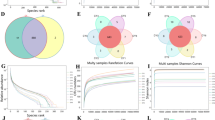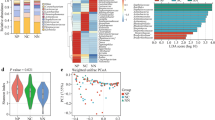Abstract
To observe the temporal shifts of the intestinal microbial community structure and diversity in rats for 30 days after death. Rectal swabs were collected from rats before death (BD) and on day 1, 5, 10, 15, 20, 25, and 30 after death (AD). Bacteria genomic DNA was extracted and V3 + V4 regions of 16S rRNA gene were amplified by PCR. The amplicons were sequenced at Illumina MiSeq sequencing platform. The bacterial diversity and richness showed similar results from day 1 to 5 and day 10 to 25 all presenting downtrend, while from day 5 to 10 showed slightly increased. The relative abundance of Firmicutes and Proteobacteria displayed inverse variation in day 1, 5, 10 and that was the former decreased, the latter increased. Bacteroidetes, Spirochaete and TM7 in day 15, 20, 25, 30 was significantly decline comparing with BD. Enterococcus and Proteus displayed reduced trend over day 1, 5, 10 and day 10, 15, 20, 25, respectively, while Sporosarcina showed obvious elevation during day 15, 20, 25. Accordingly, there was a certain correlation between intestinal flora succession and the time of death. The results suggested that intestinal flora may be potential indicator to aid estimation of post-mortem interval (PMI).






Similar content being viewed by others
References
Amendt J, Campobasso CP, Gaudry E, Reiter C, Leblanc HN, Hall MJ (2007) Best practice in forensic entomology—standards and guidelines. Int J Legal Med 121:90–104
Benbow ME, Pechal JL, Lang JM, Erb R, Wallace JR (2015) The potential of high-throughput metagenomic sequencing of aquatic bacterial communities to estimate the postmortem submersion interval. J Forensic Sci 60:1500–1510
Butzbach DM, Stockham P, Kobus HJ, Sims DN, Byard RW, Lokan RJ, Walker G (2013) Bacterial degradation of risperidone and paliperidone in decomposing blood. J Forensic Sci 58:90–100
Caporaso JG, Kuczynski J, Stombaugh J et al (2010) QIIME allows analysis of high-throughput community sequencing data. Nat Methods 7:335–336
Carter DO, Yellowlees D, Tibbett M (2007) Cadaver decomposition in terrestrial ecosystems. Naturwissenschaften 94:12–24
Centeno N, Maldonado M, Oliva A (2002) Seasonal patterns of arthropods occurring on sheltered and unsheltered pig carcasses in Buenos Aires Province (Argentina). Forensic Sci Int 126:63–70
Clemente J, Ursell L, Parfrey LW, Knight R (2012) The impact of the gut microbiota on human health: an integrative view. Cell 148:1258–1270
Damann FE, Williams DE, Layton AC (2015) Potential use of bacterial community succession in decaying human bone for estimating postmortem interval. J Forensic Sci 60:844–850
DeSantis TZ, Hugenholtz P, Larsen N et al (2006) Greengenes, a chimera-checked 16S rRNA gene database and workbench compatible with ARB. Appl Environ Microbiol 72:5069–5072
Debruyn JM, Hauther KA (2017) Postmortem succession of gut microbial communities in deceased human subjects. Peerj 5:e3437
Dent BF, Shari, Stuart B (2004) Review of human decomposition processes in soil. Environ Geol 45:576–585
Edgar RC (2010) Search and clustering orders of magnitude faster than BLAST. Bioinformatics 26:2460
Guo J, Fu X, Liao H et al (2016) Potential use of bacterial community succession for estimating post-mortem interval as revealed by high-throughput sequencing. Sci Rep 6:24197
Hauther KA, Cobaugh KL, Jantz LM, Sparer TE, Debruyn JM (2015) Estimating time since death from postmortem human gut microbial communities. J Forensic Sci 60:1234–1240
Huttenhower C, Gevers D, Knight R, Abubucker S, Badger JH, Chinwalla AT, Creasy HH, Earl AM, Fitzgerald MG, Fulton RS (2012) Structure, function and diversity of the healthy human microbiome. Nature 486:207–214
Hyde ER, Haarmann DP, Lynne AM, Bucheli SR, Petrosino JF (2013) The living dead: bacterial community structure of a cadaver at the onset and end of the bloat stage of decomposition. PLoS ONE 8:e77733
Hyde ER, Haarmann DP, Petrosino JF, Lynne AM, Bucheli SR (2015) Initial insights into bacterial succession during human decomposition. Int J Legal Med 129:661–671
Janaway RC, Percival SL, Wilson AS (2009) Decomposition of human remains. In: Percival SL (ed) Microbiology and aging. Springer, New York, pp 313–334
Kumar S, Verma AK (2016) Estimation of postmortem interval using the data of insulin level in the cadaver׳s blood. Data Brief 7:354–356
Langille MG, Zaneveld J, Caporaso JG et al (2013) Predictive functional profiling of microbial communities using 16S rRNA marker gene sequences. Nat Biotechnol 31:814–821
Lenz EJ, Foran DR (2010) Bacterial profiling of soil using genus-specific markers and multidimensional scaling. J Forensic Sci 55:1437–1442
Louis P, Hold GL, Flint HJ (2014) The gut microbiota, bacterial metabolites and colorectal cancer. Nat Rev Microbiol 12:661–672
Magoč T, Salzberg S (2011) FLASH: fast length adjustment of short reads to improve genome assemblies. Bioinformatics 27:2957–2963
Metcalf JL, Parfrey LW, Gonzalez A, Lauber CL, Dan K, Ackermann G, Humphrey GC, Gebert MJ, Treuren WV, Berg-Lyons D (2013a) A microbial clock provides an accurate estimate of the postmortem interval in a mouse model system. Elife 2:e01104
Metcalf JL, W.P.L., Gonzalez A, Lauber CL, Knights D, Ackermann G, , Humphrey GC, G.M., Van Treuren W, Berg-Lyons D, Keepers K, Guo Y, Bullard J, and Fierer N, C.D., Knight R (2013b) A microbial clock provides an accurate estimate of the postmortem interval in a mouse model system. Elife 15
Metcalf JL, Carter DO, Knight R (2016) Microbiology of death. Curr Biol 26:R561–R563
Nicholson JK, Elaine H, James K, Remy B, Glenn G, Wei J, Sven P (2012) Host-gut microbiota metabolic interactions. Science 336:1262–1267
Pechal JL, Crippen TL, Tarone AM, Lewis AJ, Tomberlin JK, Benbow ME (2013) Microbial community functional change during vertebrate carrion decomposition. PLoS ONE 8:e79035
Pechal JL, Crippen T, Benbow ME et al (2014) The potential use of bacterial community succession in forensics as described by high throughput metagenomic sequencing. Int J Legal Med 128:193–205
Putman RJ (1978) Patterns of carbon dioxide evolution from decaying carrion decomposition of small mammal carrion in temperate systems 1. Oikos 31:47–57
Rebello CJ, Burton J, Heiman M, Greenway FL (2015) Gastrointestinal microbiome modulator improves glucose tolerance in overweight and obese subjects: a randomized controlled pilot trial. J Diabetes Complications 29:1272–1276
Schmedes SE, Woerner AE, Nmm N, Wendt FR, King JL, Stephens KM, Budowle B (2018) Targeted sequencing of clade-specific markers from skin microbiomes for forensic human identification. Forensic Sci Int Genet 32:50–61
Smart JL, Kaliszan M (2012) The post mortem temperature plateau and its role in the estimation of time of death. a review. Leg Med 14:55–62
Tsuda K, Nagano H, Ando A, Shima J, Ogawa J (2017) Modulation of fatty acid composition and growth in Sporosarcina species in response to temperatures and exogenous branched-chain amino acids. Appl Microbiol Biotechnol 101:5071–5080
Yadav J, Deshpande A, Arora A, Athawal BK, Dubey BP (2007) Estimation of time since death from CSF electrolyte concentration in Bhopal region of central India. Legal Med 9:309–313
Zapico SC, Menéndez ST, Núñez P (2014) Cell death proteins as markers of early postmortem interval. Cell Mol Life Sci 71:2957–2962
Zhang LS, Davies SS (2016) Microbial metabolism of dietary components to bioactive metabolites: opportunities for new therapeutic interventions. Genome Med 8:46
Zhang Y, Qi W, Bing L, Wang Z, Li C, Yao Y, Ping H, Wang Z (2017) Changes in Attenuated Total Reflection Fourier Transform Infrared Spectra as Blood Dries Out. J Forensic Sci 62:761–767
Acknowledgements
The authors would like to thank Shakir Ullah at English Editorial Services. This work was supported by a National Natural Sciences Funding of China (project no: NSFC81730056).
Author information
Authors and Affiliations
Contributions
HL, EY, SZ, JZ, contributed equally to the study design, collection of data, development of the sampling, LY, RL, SU, QW analyses, NM, YS, CA, ZW, JX interpretation of results, and preparation of the paper. All authors read and approved the final manuscript.
Corresponding authors
Ethics declarations
Conflict of interest
The authors declare that they have no competing interests.
Ethical statement
All animal experiments were approved by the Institutional Animal Use and Care Committee of Xi’an Jiaotong University (No: 2017-388).
Additional information
Communicated by Erko Stackebrandt.
Publisher's Note
Springer Nature remains neutral with regard to jurisdictional claims in published maps and institutional affiliations.
Electronic supplementary material
Below is the link to the electronic supplementary material.
Supplementary file1 (TIF 17158 kb)
Fig. S1 Average temperature (℃) and humidity (%) during rats’ decay over 30 days.
Supplementary file2 (TIF 50656 kb)
Fig. S2 Rarefaction Measure of observed species 16S rRNA gene sequences were used to measure whether the sequence size was sufficient to satisfy the experiment requirement to estimate microbiome richness.
Supplementary file3 (TIF 143464 kb)
Fig. S3 Relative abundance of each sample at phylum level during 30 days decomposition.
Rights and permissions
About this article
Cite this article
Li, H., Yang, E., Zhang, S. et al. Molecular characterization of gut microbial shift in SD rats after death for 30 days. Arch Microbiol 202, 1763–1773 (2020). https://doi.org/10.1007/s00203-020-01889-w
Received:
Revised:
Accepted:
Published:
Issue Date:
DOI: https://doi.org/10.1007/s00203-020-01889-w




